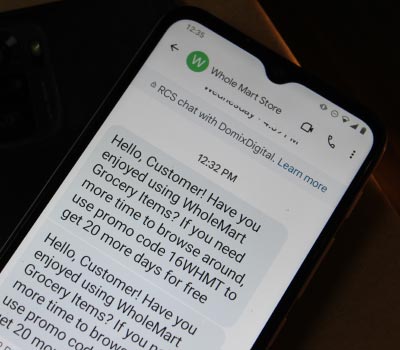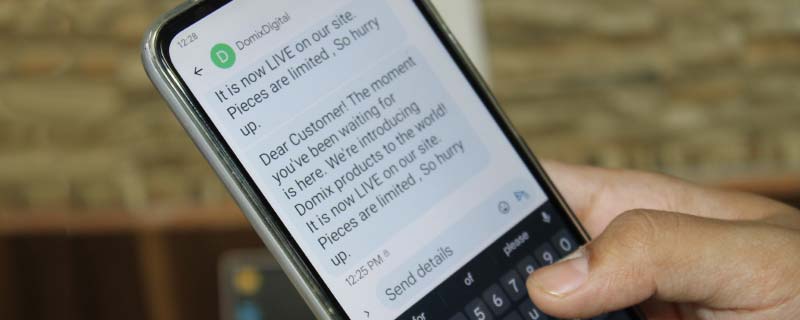Personalize SMS Marketing Messages and Measure Campaign Success
👤 Digital Deeper
📅
🕔 8 Minutes
SMS marketing can be a highly effective way to reach your target audience and promote your products or services. SMS marketing has become an increasingly popular way for businesses to reach their customers in recent years.
Personalization is key to the success of any marketing campaign, including SMS marketing. It is a cost-effective, quick and convenient way to communicate with customers, and has a high open and response rate.
How can I Measure the Success of my SMS Marketing Campaign?
The ultimate goal of an SMS marketing campaign is to generate revenue for the business. Measuring the revenue generated by the campaign is an important metric to determine its success. This can be done by tracking the sales generated from the campaign and comparing it to the cost of the campaign to determine the return on investment (ROI).However, measuring the success of an SMS marketing campaign can be a challenge. In this article, we will explore the various ways to measure the success of an SMS marketing campaign in detail.
-
Delivery Rate:
The delivery rate is the percentage of messages that are successfully delivered to the intended recipients. A high delivery rate is crucial for the success of an SMS marketing campaign. If a large number of messages are not delivered, the campaign is unlikely to generate the desired results. The delivery rate can be measured by dividing the number of messages delivered by the total number of messages sent and multiplying the result by 100.
-

-
Open Rate:
The open rate is the percentage of messages that are opened by the recipients. This is an important metric to track because it tells you how many people are actually reading your messages. A high open rate indicates that your messages are engaging and relevant to your audience. The open rate can be measured by dividing the number of messages opened by the total number of messages delivered and multiplying the result by 100.
-
Click-through Rate:
The click-through rate (CTR) is the percentage of recipients who click on a link in the message. This metric is particularly important if your SMS marketing campaign includes a call-to-action (CTA) such as a link to a website or a special offer. A high CTR indicates that your message was persuasive enough to encourage recipients to take action. The CTR can be measured by dividing the number of clicks by the total number of messages delivered and multiplying the result by 100.
-
Conversion Rate:
The conversion rate is the percentage of recipients who complete a desired action, such as making a purchase, after clicking on a link in the message. This metric is particularly relevant for e-commerce businesses. A high conversion rate indicates that your message and CTA were persuasive enough to encourage recipients to take the desired action. The conversion rate can be measured by dividing the number of conversions by the total number of clicks and multiplying the result by 100.
-
List Growth Rate:
The list growth rate is the percentage of new subscribers who have signed up for your SMS marketing list. This metric is particularly relevant for businesses looking to expand their customer base. A high list growth rate indicates that your marketing efforts are effective at attracting new subscribers. The list growth rate can be measured by dividing the number of new subscribers by the total number of existing subscribers and multiplying the result by 100.
-
Opt-out Rate:
The opt-out rate is the percentage of subscribers who have unsubscribed from your SMS marketing list. This metric is important because it tells you how many people are not interested in receiving your messages. A high opt-out rate may indicate that your messages are not relevant or engaging enough for your audience. The opt-out rate can be measured by dividing the number of opt-outs by the total number of messages delivered and multiplying the result by 100.
-
Response Time:
The response time is the time it takes for recipients to respond to your message. This metric is important because it tells you how engaged your audience is with your messages. A quick response time indicates that your message was relevant and persuasive enough to elicit an immediate response.
How can I Personalize SMS Marketing Messages for my Audience?

Personalized messages are more engaging and relevant to the recipient, increasing the chances of them taking action. In this article, we will explore the various ways to personalize SMS marketing messages for your audience.
-
Use the Recipient's Name:
One of the simplest ways to personalize an SMS message is to include the recipient's name in the message. This can be done by using merge tags, which automatically insert the recipient's name into the message. Using the recipient's name in the message creates a sense of familiarity and can increase the chances of the recipient engaging with the message.
-
Segment your Audience:
Segmenting your audience involves dividing your SMS marketing list into different groups based on certain criteria, such as age, location, interests, or purchasing behavior. By segmenting your audience, you can send targeted messages that are tailored to the specific interests and needs of each group. For example, if you have a list of customers who have recently purchased a particular product, you can send them a message with a special offer on related products.
-
Use Customer Data:
Customer data, such as purchase history, browsing behavior, and location, can be used to personalize SMS marketing messages. For example, if a customer has recently purchased a particular product, you can send them a message with related products or accessories. If a customer has browsed a particular category on your website, you can send them a message with a special offer on products in that category.
-
Send Personalized Offers:
Sending personalized offers is a great way to increase engagement with your SMS marketing messages. Personalized offers can be based on the customer's purchase history, browsing behavior, or location. For example, you can send a customer who has recently purchased a product a message with a special offer on related products or accessories. You can also send a customer who is near one of your physical stores a message with a special offer to encourage them to visit the store.
-
Use Emojis:
Emojis are a great way to add personality and emotion to SMS marketing messages. They can be used to convey a message in a more engaging and fun way. However, it is important to use emojis in moderation and make sure they are relevant to the message and audience.
-
Use Language that Resonates
with your Audience:
Using language that resonates with your audience is crucial to personalizing SMS marketing messages. This involves using words and phrases that are familiar and relevant to your audience. For example, if you are targeting a younger audience, you may want to use more informal language and emojis, while if you are targeting an older audience, you may want to use more formal language and avoid using emojis.
-
Consider the Timing of your
Messages:
The timing of your messages is an important factor to consider when personalizing SMS marketing messages. For example, if you are targeting busy professionals, you may want to send messages during lunch breaks or after work hours. If you are targeting college students, you may want to send messages during the afternoon or evening when they are more likely to be free.
-
Personalize the Call-to-Action
(CTA):
Personalizing the CTA in SMS marketing messages is a great way to increase engagement and conversion rates. For example, instead of using a generic CTA like "Shop Now," you can use a personalized CTA like "Get Your 20% Discount Now." This creates a sense of urgency and encourages the recipient to take immediate action.
What are Some Common Mistakes to Avoid in SMS Marketing?
However, it's important to avoid common mistakes that can hinder your success and even damage your brand's reputation. Some of the most common mistakes to avoid in SMS marketing:-
-
01 Failing to get Permission:
Mistakes you can make SMS marketing failing get permission from your recipients. Send messages to people who have not opted-in to receive them. Violates regulations and puts you at risk of legal action, but damage your brand's reputation.
-
02 Not Providing Value
Another common mistake in SMS marketing is not providing value to your recipients. If you only send promotional messages or offers that don't resonate with your audience, they're likely to quickly lose interest and unsubscribe from your list.
-
03 Sending too many Messages
Sending too many messages is another common mistake in SMS marketing. While it's important to stay top-of-mind with your audience, bombarding them with messages can be overwhelming and lead to high unsubscribe rates.
-
04 Ignoring Regulations
SMS marketing is highly regulated, and ignoring these regulations can result in legal action and damage to your brand's reputation. Some key regulations include obtaining explicit, providing an easy way to unsubscribe.
-
05 Failing to Personalize Messages
Personalization is key in SMS marketing, as it helps to build a stronger connection with your audience and increase engagement. Failing to personalize your messages can lead to lower response rates.
-
06 Using Unclear Language
Another vital mistake in SMS marketing is using unclear language in SMS messages that can confuse or mislead your targeted audience. This can lead to frustration and a lack of trust in your brand.
⯮ Always make sure you have obtained explicit permission from your recipients before sending them any messages. You can do this by including opt-in language on your website or in your physical store, or by asking customers to opt-in through a text message.
⯮ Focus on providing value to your recipients in every message you send. This could mean sharing helpful tips or advice related to your industry, offering exclusive discounts or promotions, or sending personalized messages that show you understand your customers' needs and preferences.
⯮ Be strategic about how often you send messages. Consider your audience's preferences and behavior, as well as your business goals, when determining the frequency of your messages. Generally, one to two messages per week is a good starting point, but you should adjust based on your results and feedback from your audience.
⯮ Stay up-to-date on the latest regulations related to SMS marketing, and make sure you are following them closely. This may require partnering with a reputable SMS marketing provider that has expertise in compliance and best practices.
⯮ Use the data you have about your audience to personalize your messages. This could mean including their name in the message, referencing their past purchases or behavior, or sending messages based on their location or preferences.
⯮ Be clear and concise in your messages. Use language that is easy to understand and avoid using industry jargon or complicated terms. Make sure your messages are also aligned with your brand's voice and tone, so that your audience feels a strong connection to your brand.